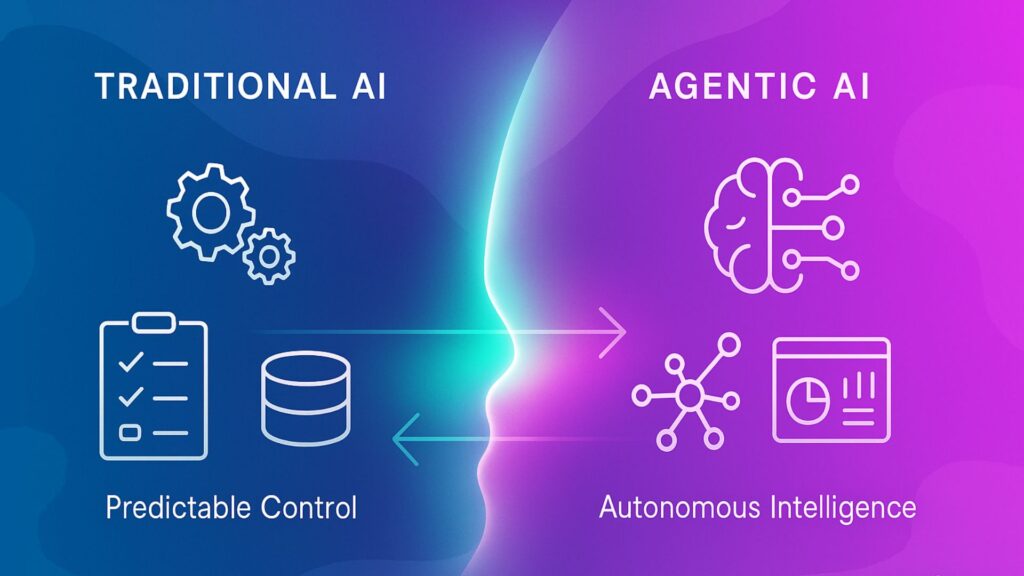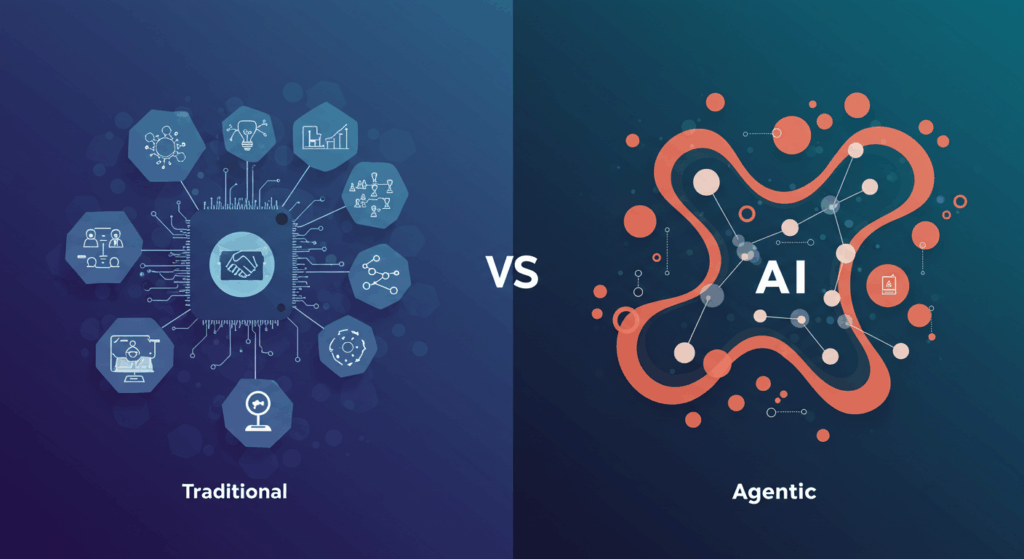Agentic AI is part of autonomous systems that can plan, execute, and optimize complex workflows independently.
- Unlike traditional AI that follows predetermined rules or generative AI that creates content on demand, agentic AI tools operate like digital teammates.
- Content and marketing teams move from task-by-task management to goal-based orchestration.
- Agentic systems deliver measurable improvements in efficiency.
- Implementation requires strategic planning and organizational readiness.
The future belongs to organizations that embrace this autonomous approach to scale operations while maintaining control.
While most marketing teams have grown comfortable with generative AI tools for content creation and traditional AI for automation, a new category of intelligent systems is emerging that promises to redesign how businesses operate.
Agentic AI tools are more than just another technological advancement. By 2029, AI agents will resolve 80% of common customer service issues without human intervention, leading to a 30% reduction in operational costs. This shift from reactive assistance to proactive problem-solving marks an evolution in how enterprise platforms approach content operations and marketing automation.
But how do agentic AI tools differ from the traditional AI systems that content and marketing teams currently rely on? Understanding these differences will tell you which approach will best serve your organization’s marketing and content operations goals.
What Are Traditional AI Tools and How Do They Work?
Traditional AI encompasses the rule-based systems, machine learning models, and automation tools that have powered business operations until recently. These systems excel at specific, well-defined tasks but operate within predetermined parameters set by human programmers.
In content and marketing contexts, traditional AI typically includes recommendation engines that suggest products based on purchase history, email automation tools that trigger campaigns based on user behavior, and predictive analytics that forecast trends using historical data. These tools follow “if-then” logic structures and require human intervention to adapt when conditions change.
Key characteristics of traditional AI tools include:
- Rule-based decision making that follows predetermined workflows
- Task-specific functionality designed for narrow use cases
- Human oversight for setup, monitoring, and updates
- Static responses that don’t evolve without manual programming changes
- Reactive operation that responds to inputs rather than initiating actions
For example, a traditional email marketing platform might automatically send a welcome series to new subscribers, but it can’t analyze campaign performance, identify optimization opportunities, or redesign the entire sequence without human input. The system executes what it’s programmed to do, nothing more.
What Makes Agentic AI Tools Different from Traditional Systems?
How do agentic AI tools differ from their traditional counterparts? The differences in AI tools encompass autonomy and adaptability. While traditional AI systems execute predefined tasks, agentic AI tools can understand goals, develop strategies, and independently execute complex workflows.
Agentic AI tools combine the pattern recognition of machine learning with advanced reasoning for independent decision-making. These systems can break down complex objectives into smaller tasks, simultaneously coordinate multiple actions, and adapt their approach based on real-time feedback.
Core capabilities that define agentic AI include:
- Goal-oriented behavior that focuses on outcomes rather than tasks
- Multi-step planning that sequences complex workflows autonomously
- Real-time adaptation that adjusts strategies based on changing conditions
- Tool integration that connects with external systems and APIs
- Contextual reasoning that considers broader implications of decisions
Unlike traditional systems that wait for human instructions, agentic AI tools proactively identify opportunities, test hypotheses, and optimize performance. They function more like digital colleagues who understand your objectives and work toward achieving them independently.
Companies implementing agentic AI systems report 46% faster content creation speeds and 32% improvement in content editing efficiency, demonstrating the practical impact of this autonomous approach.
Agentic vs Traditional AI: What Are the Key Differences Across Critical Dimensions?
Understanding differences in agentic vs traditional AI tools requires examining how each system handles various operational aspects. The following comparison highlights where each approach excels and where limitations become apparent.
Decision-Making Capabilities
Traditional AI tools rely on predefined decision trees and rule-based logic. When faced with scenarios outside their programming, these systems either fail or default to generic responses. Updates require developers to modify code and retrain models.
Agentic AI tools use probabilistic reasoning and contextual understanding to make informed decisions even in uncertain environments. They can weigh multiple factors, consider trade-offs, and select optimal paths without predetermined rules for every scenario.

Learning and Adaptation
When evaluating the differences in AI tools, traditional systems learn through periodic retraining on new datasets, typically requiring significant computational resources and human oversight. Learning is batch-oriented and happens during scheduled maintenance windows.
Agentic systems engage in continuous learning, updating their understanding based on real-time interactions and outcomes. This approach leads to rapid adaptation to changing conditions without manual intervention or system downtime.
Scope of Operation
Traditional AI tools excel within narrow, well-defined domains. Email marketing platforms handle campaigns, recommendation engines suggest products, and analytics tools generate reports. Integration between systems requires custom development and ongoing maintenance.
Agentic AI tools operate across broader domains, coordinating actions between multiple systems and platforms. A single agentic system might manage campaign creation, audience segmentation, content optimization, and performance analysis as interconnected workflows.
Resource Requirements
Traditional implementations often require specialized technical teams for setup, monitoring, and optimization. Organizations need data scientists, machine learning engineers, and integration specialists to maintain effective operations.
Agentic systems reduce technical overhead by automating many optimization tasks. While initial setup requires expertise, ongoing management focuses more on strategic oversight than technical maintenance.
How Do Traditional and Agentic AI Handle Content Marketing Workflows?
The autonomous vs generative AI distinction becomes clearest when examining real-world content marketing applications. Both approaches serve important roles, but they address different operational challenges.
Content Creation and Planning
Traditional AI assists with content creation through templates, automated writing tools, and image generation platforms. Human teams provide prompts, review outputs, and make strategic decisions about content direction. Planning remains largely manual, with AI providing data insights to inform human decision-making.
Agentic AI manages entire content planning cycles, from identifying content gaps and analyzing audience needs to developing editorial calendars and coordinating asset creation. These systems can autonomously research trending topics, assess competitive landscapes, and recommend content strategies that align with business objectives.
Campaign Management and Optimization
Traditional campaign management relies on preset triggers and basic A/B testing frameworks. Marketers define test parameters, monitor results, and manually implement changes based on performance data. Optimization cycles are periodic and require human analysis to identify opportunities for improvement.
Agentic AI continuously monitors campaign performance across all channels, automatically testing variations in messaging, timing, and targeting. These systems can reallocate budgets between underperforming and high-converting campaigns, adjust audience segments based on engagement patterns, and optimize creative elements in real time.

Personalization and Customer Experience
Traditional personalization engines use demographic data and purchase history to segment audiences and deliver targeted content. While effective, these approaches rely on broad categorizations and struggle to account for individual behavioral nuances.
Agentic AI creates dynamic, individual-level personalization by analyzing micro-interactions, predicting intent, and adapting content delivery based on behavioral signals. These systems can modify website experiences, email content, and ad creative for each user interaction.
Benefits and Limitations: When to Choose Each Approach
Both traditional and agentic AI tools offer distinct advantages depending on organizational needs, technical maturity, and strategic objectives. Understanding these trade-offs helps teams make informed implementation decisions.
Traditional AI Benefits
Predictability and control are the primary advantages of traditional AI systems. Organizations know exactly how these tools will respond to specific inputs, making them ideal for compliance-heavy industries and workflows requiring detailed audit trails.
Lower initial complexity makes traditional AI more accessible for teams with limited technical resources. Implementation typically follows established patterns, and troubleshooting relies on well-documented processes.
An established vendor ecosystem provides numerous solution options with proven track records. Organizations can select from mature platforms with extensive support resources and integration capabilities.
Traditional AI Limitations
Scalability constraints become apparent as content demands increase. Manual oversight creates bottlenecks that limit operational efficiency, particularly for teams managing multiple campaigns across various channels.
Adaptation lag means traditional systems can’t respond quickly to market changes, competitive actions, or shifts in customer behavior. Updates require development cycles that may miss time-sensitive opportunities.
Agentic AI Benefits
Operational efficiency improves as autonomous systems handle complex workflows without constant supervision. Teams can focus on planning while AI agents manage execution and optimization tasks.
Adaptive intelligence enables real-time responses to changing conditions. Agentic systems can identify emerging trends, automatically adjust strategies, and optimize performance without waiting for human intervention.
Scalable personalization becomes feasible at enterprise levels, with AI agents simultaneously creating individual-level experiences across thousands or millions of customer interactions.
Agentic AI Limitations
Implementation complexity requires more sophisticated planning and technical expertise during initial deployment. Organizations need clear governance frameworks and success metrics before launching autonomous systems.
Trust development takes time as teams learn to work with AI agents that make independent decisions. Establishing appropriate oversight and intervention protocols is essential for successful adoption.

What Should Content and Marketing Teams Consider Before Agentic AI Implementation?
Successfully deploying either traditional or agentic AI requires careful planning that aligns technological capabilities with organizational readiness and strategic objectives.
Assessing Organizational Readiness
Data infrastructure maturity forms the foundation for effective AI implementation. Traditional AI systems require clean, structured datasets for training and operation. Agentic AI systems need comprehensive data integration that connects customer interactions, content performance, and business outcomes across all platforms.
Evaluate your current data quality, integration capabilities, and governance processes before selecting autonomous vs generative AI tools. Teams with fragmented data systems may benefit from traditional AI implementations that can operate with limited datasets, while organizations with mature data operations can leverage agentic AI’s cross-platform intelligence.
Team expertise and change management considerations vary depending on your choices. Traditional AI often requires specialized technical skills for ongoing management. Agentic AI systems shift requirements toward strategic oversight and performance management rather than technical troubleshooting.
Integration Strategy and Timeline
Phase-based implementation reduces risk and allows teams to gradually build confidence with AI systems. Organizations often begin with traditional AI tools for specific use cases and then expand to agentic systems as they develop operational expertise and data maturity.
AI agents in digital marketing typically follow a progression from assistive tools to autonomous systems. This evolution allows teams to maintain control while gradually delegating more complex decisions to AI agents.
Success metrics and governance frameworks ensure AI delivers measurable business value. Traditional AI projects often focus on efficiency metrics like time savings and error reduction. Agentic AI requires broader success measures that include strategic outcomes and adaptive performance indicators.

What Is the Future of AI Tools in Content Operations?
Industry trends indicate a clear trajectory toward more autonomous, intelligent systems that can handle complex business challenges. Understanding these developments helps organizations prepare for the next wave of AI innovation.
Emerging Capabilities and Trends
Multi-agent collaboration is the next frontier in agentic AI development. Instead of single systems handling all tasks, specialized AI agents will coordinate to manage different aspects of content operations. For example, one agent might focus on audience research while another optimizes content distribution, with both systems sharing insights and coordinating strategies.
Recent advances in AI agent workflows demonstrate how multiple autonomous systems can work together to achieve complex objectives that exceed what individual agents or traditional AI tools can accomplish.
Real-time business intelligence will become standard as agentic systems provide continuous insights rather than periodic reports. Marketing teams will shift from reactive analysis to proactive strategy adjustment based on AI-generated intelligence.
Strategic Implications for Organizations
The transition from traditional to agentic AI requires fundamental changes in how teams operate and make decisions. Organizations that successfully navigate this transition will gain competitive advantages in efficiency, agility, and customer experience quality.
Skills evolution will emphasize strategic thinking and AI collaboration rather than tactical execution. Marketing professionals will function as AI orchestrators, setting objectives and governance parameters while autonomous systems handle implementation details.
The most successful implementations will combine human creativity and strategic insight with AI capabilities for execution and optimization. This partnership maximizes the strengths of both human and artificial intelligence while mitigating respective limitations.
Frequently Asked Questions
What’s the typical cost difference between traditional AI and agentic AI implementations?
Agentic AI systems require a higher upfront investment than traditional AI due to complex integration and training requirements. However, they reduce ongoing operational costs by eliminating constant human oversight and manual optimization.
How do I maintain brand control when AI agents make autonomous decisions?
Agentic AI operates within governance frameworks you define, including brand guidelines, approval thresholds, and content parameters. You set “guardrails” that prevent agents from acting outside specified boundaries and implement escalation protocols for high-risk decisions. The system maintains audit trails for all actions and includes rollback capabilities. Success depends on establishing clear brand standards during setup rather than controlling individual decisions.
Do marketing teams need special training to work with agentic AI systems?
Teams need training focused on AI collaboration rather than technical skills. Instead of learning multiple tools, marketers learn to set objectives, interpret AI insights, and make high-level strategic decisions. This transition typically takes months and elevates teamwork from tactical execution to strategic planning. Most platforms provide comprehensive onboarding support.
Choosing the Right AI Approach for Your Organization
The decision between traditional and agentic AI tools should align with your organization’s current capabilities, strategic objectives, and growth trajectory. Rather than viewing these approaches as mutually exclusive, consider how they might complement each other in a comprehensive AI strategy.
How do agentic AI tools differ in their requirements and outcomes compared to traditional systems? Agentic AI excels in complex, dynamic environments where adaptive decision-making creates competitive advantages. Traditional AI remains valuable for stable, well-defined processes where predictability and control are paramount.Aprimo’s AI-powered platform combines the best of both traditional and agentic AI approaches, helping teams scale content operations while maintaining strategic control and brand consistency. Request a demo today to discover how our AI agents can make a difference in your content operations.


